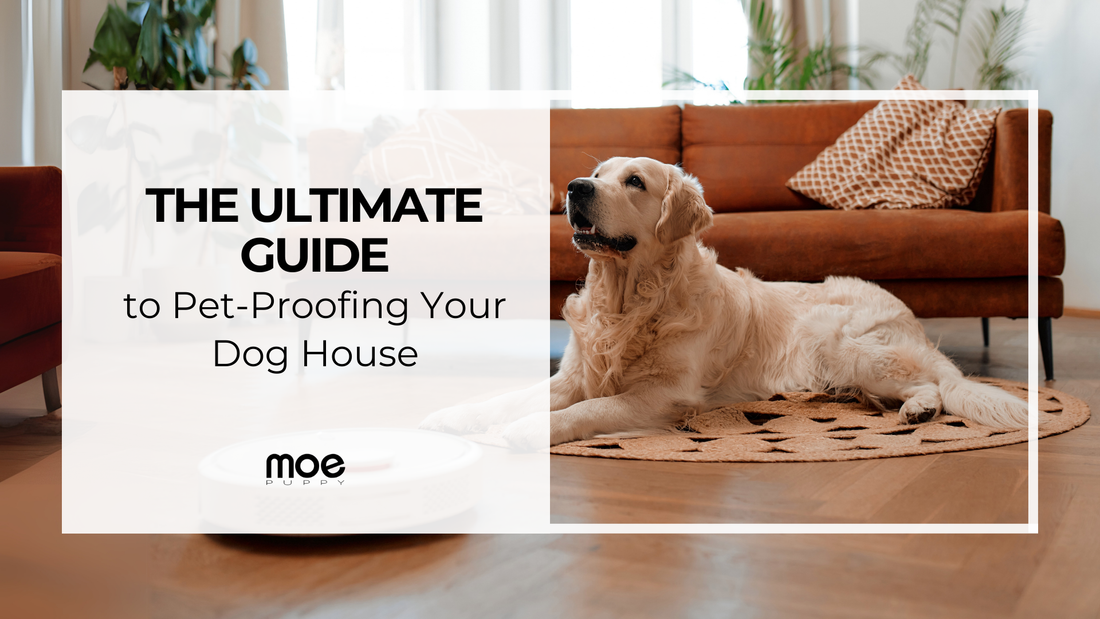
The Ultimate Guide to Pet-Proofing Your Dog House
Share
Introduction
Your furry friend deserves a safe and cozy place to rest. But have you considered how pet-proof your dog house really is? Just like baby-proofing a home, pet-proofing a dog house ensures your pup stays safe, comfortable, and protected from hazards. Whether you're setting up a new dog house or upgrading an old one, this guide covers everything you need to know.
1. Flooring: Safe and Durable Options
The type of flooring in your dog’s house can significantly impact their health and safety. Many household floor cleaners contain toxic ingredients such as ammonia and bleach, which can be harmful to pets. These chemicals can irritate their paws, cause respiratory issues, and lead to poisoning if ingested. Instead, use pet-safe floor cleaners made with natural ingredients.
Additionally, slippery floors can increase the risk of injury. Choose textured, non-slip flooring materials such as rubber mats or sealed wood. Ensure that the flooring is moisture-resistant to prevent mold and bacterial growth, which could lead to infections.
2. The Hidden Dangers of Toxic Plants
Many plants that beautify our homes and gardens can be dangerous to dogs. If your dog house is near your garden or backyard, be mindful of the plants around them. Some of the most common toxic plants for dogs include:
- Lilies – Can cause kidney failure.
- Oleander – Highly toxic and can lead to heart issues.
- Sago Palm – Can cause severe liver failure.
- Azaleas & Rhododendrons – Lead to vomiting, diarrhea, and potential fatality.
To ensure your dog’s safety, research pet-safe plants and remove any harmful ones from their surroundings. Consider using dog-friendly plants like basil, rosemary, or spider plants instead.

3. Avoiding Toxic Materials
Many common household materials can be harmful to dogs, especially if they chew on them. Some materials to avoid include:
- Treated wood – Contains chemicals that can be toxic if chewed or licked.
- Lead-based paints – Can cause poisoning if ingested.
- Certain adhesives & glues – Some contain toxic substances harmful to pets.
Instead, opt for non-toxic, pet-safe building materials. If painting or sealing the dog house, use VOC-free, non-toxic paints and finishes. Dogs often explore their environment with their mouths, so every element in their house should be safe for chewing.
4. Keeping Water and Food Safe
Many pet owners forget to clean their dog’s food and water bowls regularly, leading to bacterial buildup. This can cause health problems, including dental disease and digestive issues. Water left stagnant in a bowl can develop algae and harmful bacteria, making it unsafe for drinking.
Best Practices for Keeping Food and Water Safe:
- Wash food and water bowls daily with pet-safe dish soap.
- Use stainless steel or ceramic bowls instead of plastic to prevent bacteria buildup.
- Always provide fresh, clean water, especially in hot weather.
- Store pet food properly to avoid contamination from pests or mold.
- Maintain Oral Hygiene – Dental health is crucial for preventing infections and other health issues. Use a dental spray for dogs Moe Puppy Dental Spray to keep their teeth clean and reduce plaque buildup.

5. Preventing Pests and Insects
Fleas, ticks, mosquitoes, and other insects can pose a significant threat to your pet’s health. These pests can carry diseases and cause severe discomfort. To keep your dog’s space pest-free:
- Regular Cleaning – Sweep and disinfect the dog house frequently to remove food crumbs and debris where pests can thrive.
- Natural Repellents – Avoid using strong chemical sprays. Instead, use natural repellents like cedar chips, neem oil, or food-grade diatomaceous earth.
- Proper Waste Disposal – Keep the area around the dog house clean and free of feces, as waste attracts flies and other insects.
- Check for Pests Regularly – Inspect your dog’s coat for fleas and ticks and use vet-approved flea prevention methods.
6. Reducing Noise and Scent Sensitivity
Dogs have an acute sense of hearing and smell, making them highly sensitive to loud noises and strong scents. Avoid placing the dog house near noisy areas like traffic or construction zones, as constant noise can cause stress and anxiety.
Similarly, strong artificial fragrances, such as scented candles, air fresheners, or heavily perfumed bedding, can be overwhelming for dogs. Stick to mild, natural scents and ensure proper airflow inside the dog house.
7. Keeping Pet Accessories Clean and Safe
Your dog's belongings, such as their bed, toys, leash, and harness, can harbor bacteria, dust, and pests. Regular cleaning and disinfecting of these items are essential to prevent infections and maintain their health.
Best Practices for Cleaning Pet Accessories:
- Wash your dog’s bed and blankets weekly using pet-safe detergent.
- Clean toys regularly to remove bacteria and dirt buildup.
- Disinfect leashes, harnesses, and collars to prevent germs from spreading.
- Use a pet-safe disinfectant spray like Moe Puppy Multi-Action Disinfectant) to safely sanitize their belongings without exposing them to harmful chemicals.

8. Creating a Comfortable and Safe Environment
Beyond removing hazards, it’s essential to create a cozy and inviting space for your pup. Here are a few extra steps you can take:
- Provide soft, chew-resistant bedding – Orthopedic or memory foam beds are great for older dogs.
- Ensure proper ventilation – Prevent overheating by allowing fresh air to circulate.
- Weatherproof the dog house – Keep the house insulated and waterproof to protect against harsh weather conditions.
By prioritizing your dog's safety and comfort, you create a space where they feel secure and happy.
Conclusion
Pet-proofing your dog’s house is about more than just creating a shelter—it’s about ensuring a safe, clean, and comfortable environment. From choosing non-toxic materials to preventing pests, maintaining hygiene, and disinfecting their belongings, every detail plays a role in your dog’s well-being. By following these steps, you can give your furry friend the secure and cozy home they deserve.

